NavSource Online: Service Ship Photo Archive
USS Cyclops (II) (Fuel Ship #4)
Nan - Dog - Yoke
Awards, Citations and Campaign Ribbons
Mexican Service Medal - World War I Victory Medal (with bronze star in lieu of Transport clasp)
Please report any broken links or trouble you might come across to the Webmaster. Please take a moment to let us know so that we can correct any problems and make your visit as enjoyable and as informative as possible.
| Click On Image For Full Size Image |
Size | Image Description | Source | |
|---|---|---|---|---|
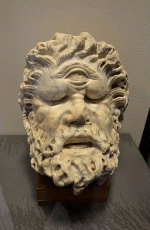
09029116 |
33k | A first century CE head of a Cyclops, part of the sculptures adorning the Roman Colosseum. Source photo by Steven Lek, courtesy Wikipedia. |
Tommy Trampp | |
 |
258k | Artist illustration of USS Cyclops moored pierside, date and location unknown. | Jim Kurrasch Battleship Iowa Pacific Battleship Center |
|
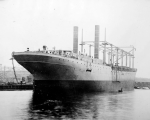 |
115k | USS Cyclops was one of four Proteus-class colliers built for the United States Navy several years before World War I. Named for the Cyclops, a primordial race of giants from Greek mythology, she was the second U.S. Naval vessel to bear the name. The loss of the ship and 306 crew; passengers; and German Prisoners without a trace within the area known as the Bermuda Triangle some time after 4 March 1918 remains the single largest loss of life in U.S. Naval history not directly involving combat. The cause of the ship's loss is unknown although she was sailing loaded with manganese ore. The modern theory is a coal bunker fire ignited the manganese causing a massive explosion resulting in her bottom being blown out or cut in half. This probably occurred in the middle of the night resulting in no survivors from her sinking without lifeboats being launched. This photo is part of the Harris & Ewing Collection in the Library of Congress online catalog. The image was taken sometime between 1909 and 1914. | Tommy Trampp | |
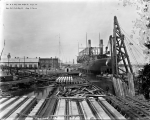 |
460k | USS Cyclops moored pierside at Norfolk Navy Yard, 3 August 1911.
US National Archives stillpix/181-v-0791 |
Michael Mohl | |
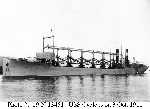 |
63k | USS Cyclops photographed by the New York Navy Yard, probably while anchored in the Hudson River, NY, 3 October 1911. US National Archives photo # 19-N-13451, a US Navy photo from the Bureau of Ships Collection now in the U.S. National Archives. |
US Naval Historical Center | |
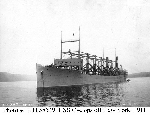 |
69k | USS Cyclops, anchored in the Hudson River, off New York City, 3 October 1911. Photograph was taken by the New York Navy Yard.
US Navy photo # NH 55549 |
US Naval Historical Center | |
 |
121k | USS Cyclops, anchored in the Hudson River, off New York City, probably during the 1911 naval review in New York City. Library of Congress, LC-B2- 2335-8 |
Mike Green | |
 |
71k | USS Cyclops photographed by Sargent, circa 1913. Copied from the album of Francis Sargent, courtesy of Commander John Condon, 1986. US Naval photo # NH 101063 |
US Naval Historical Center | |
 |
72k | USS Cyclops and USS South Carolina (Battleship No. 26) engaged in an experimental coaling while under way at sea in 1914. Rigging between the two ships was used to transfer two 800-pound bags of coal one at a time. The bags were landed on a platform in front of the battleship's forward 12-inch gun turret, and then carried to the bunkers. The donor, who served as a seaman in South Carolina at the time, comments: "it showed that this was possible but a very slow method of refueling. Nothing was heard of the test afterwards." US Navy photo # NH 76012 donated by Earle F. Brookins, Jamestown, NY, 1972. |
US Naval Historical Center | |
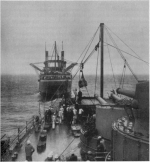 |
104k | Tests of Spencer Miller's coaling-at-sea rig were conducted in 1914 between the USS Cyclops (Fuel Ship # 4) and the battleship USS South Carolina (Battleship No. 26). The battleship was equipped with a sliding padeye attached to a vertical spar mounted on South Carolina's fore deck that was used to raise and lower the highline along with the load. US. Navy Photo. |
Robert Hurst | |
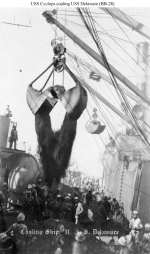 |
137k | USS Cyclops (Fuel Ship # 4) refueling the battleship
USS Delaware (Battleship No. 28). A clamshell bucket is dumping coal on the deck of the battleship
while another bucket is in operation further aft. The battleship's entire crew is trying to shovel the heaps of coal on deck into chutes leading to the coal bunkers
below. Each bucket carried 4,000 pounds of coal. Cyclops could operate twelve buckets at once, one for each of the ship's cargo coal holds.
US Navy Photo courtesy Shipscribe.com. |
Mike Green | |
 |
32k | USS Cyclops under way, date and location unknown. Photo courtesy Philadelphia Archdiocesan Historical Research Center |
Colin P. Varga Photography Curator PAHRC | |
 |
43k | USS Cyclops under way, date and location unknown. Photo source "Jane's Fighting Ships 1914" |
Robert Hurst | |
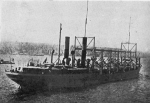 |
255k | USS Cyclops under way, date and location unknown. US Navy photo from "A History of The Transport Service: Adventures And Experiences Of United States Transports And Cruisers In The World War", by Vice Admiral Albert Gleaves, USN, published by George H. Doran Company, New York. |
Robert Hurst | |
 |
89k | USS Utah (Battleship No. 31) looking forward from atop # 4 12" gun turret while coaling simultaneously from two colliers at the rate of 841 tons per hour
prior to World War I. The ship's band is stationed on top of # 3 turret. The two colliers are USS Cyclops (Fuel Ship No. 4) on the left and either
USS Orion (Fuel Ship No. 11) or
USS Jason (Fuel Ship No. 12) on the right. Cyclops had Mead-Morrison coal
handling gear while the other collier had Lidgerwood gear. Text, courtesy John Spivey Photo US Naval History and Heritage Command photo # NH 61262 |
US Naval History and Heritage Command | |
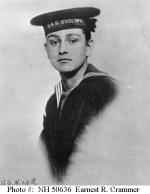 |
54k | Seaman Earnest Randolph Crammer, U.S. Navy who was lost with USS Cyclops in March 1918. His cap band is from that ship. US Naval History and Heritage Command Photo # NH 50636 |
Robert Hurst | |
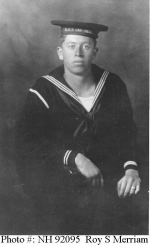 |
58k | Coxswain Roy Stuart Merriam, U.S. Navy, who was lost with USS Cyclops in March 1918.
His cap band is from USS San Diego (Armored Cruiser No. 6). US Naval History and Heritage Command Photo # NH 92095 |
Robert Hurst | |
| 01 | Master, Worley, George William (Naval Auxiliary Service) | 7 November 1910 - 3 March 1918 |
| Back To The Navsource Photo Archives Main Page | Back To The Service Ship Photo Index | Back To The Collier (AC) Photo Index |
| Comments, Suggestions, E-mail Webmaster. |
|
This page is created and maintained by Gary P. Priolo |